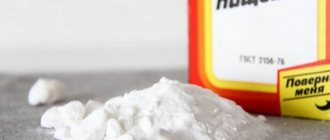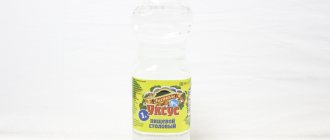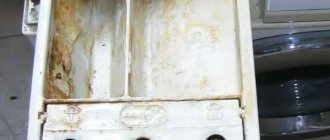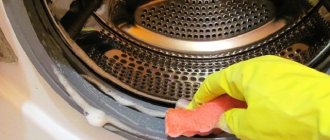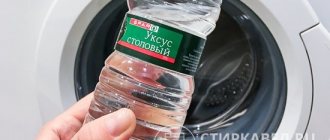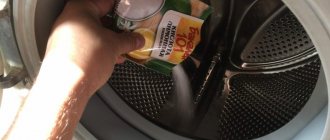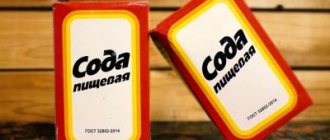Washing machines are indispensable assistants for modern housewives. Failure of the device entails problems - financial costs, and also the need to regularly wash clothes by hand. To extend the life of the washing machine, you need to follow the rules and conditions of its operation, regularly clean the internal parts from scale, debris, and dirt.
To do this, you don’t have to buy expensive drugs - you can use what you can find in the kitchen: vinegar, citric acid, soda. When used correctly, they remove dirt even in the most difficult to reach places and extend the life of the household appliance. How to clean an automatic washing machine with citric acid or other means?
The need for periodic cleaning
The washing machine must be cleaned regularly. This will allow it to be in working condition for a long time and efficiently. The peculiarity of this household appliance is that it can accumulate:
- powder residues;
- fungal and mold formations;
- unpleasant odors;
- scale
These shortcomings will subsequently lead to the fact that after washing the laundry in the machine, it will not be as clean as before. Therefore, it is necessary to clean the equipment once a month. And if you have a pet, it is advisable to carry out the procedure more often.
Causes of scale formation on automatic machine elements
Scale is the first “enemy” of heating equipment, exhibiting a dangerous destructive effect. Scale reduces the level of thermal conductivity of metals, activates corrosion processes, and increases energy costs when using equipment.
The cause of scale is the salts and impurities contained in the water. Despite filtration systems, tap water cannot be completely purified from various types of contaminants.
The more various impurities in the water, the higher its level of hardness.
The cause of scale formation, and therefore machine breakdowns, is the use of hard water. When a liquid is heated, the impurities it contains are decomposed into two groups - carbon dioxide and salt deposits. Insoluble sediments are deposited on the surface of the heating elements, forming scale.
Water with a high content of magnesium and calcium is considered the hardest.
A few simple signs will help determine the need for urgent descaling of equipment:
- The laundry is not washed well - things remain gray and have an unpleasant smell.
- During operation, the machine makes uncharacteristic sounds.
- The consumption of detergents increases.
Having discovered scale on the heating elements of equipment, it is necessary to urgently clean it.
How to make the descaling procedure as fast, effective and safe as possible?
The difference between baking soda and soda ash
Soda powder is a product of natural origin that has a deodorizing and cleansing effect, and also helps to neutralize acid and other compounds, which allows you to soften water.
Sodium compounds are the basis of both soda ash and baking soda. A distinctive feature of these species is the formula of the chemical structure. Baking soda powder is much milder in its effect. It contains alkali in small doses, which makes the product completely safe for the human body. And soda ash (sometimes called technical soda) is a strong alkali, when using which you must strictly follow safety rules.
Important! The use of soda ash when cleaning the machine gives the best result, since it is more abrasive and effectively removes plaque and dirt.
Eliminating unpleasant odor
One of the signs of a clogged washing machine is the appearance of an odor due to bacteria and mold. The source must be removed. Baking soda is good for removing mold buildup. Mix it with vinegar in a one to one ratio. Wipe the parts where the risk of mold colonies is especially high: seal (cuff), drum, powder container.
Microorganisms that settle inside the machine release substances that have an unpleasant odor.
Their reproduction is due to the following reasons:
- incomplete drainage of water after washing;
- setting low temperatures when washing clothes;
- use of low-quality washing powders;
- use of hard water;
- incorrect connection of the drain hose to the sewer.
Limescale deposits can also give off an unpleasant odor.
To avoid having to take your car for repairs, clean its working parts regularly
Descaling with baking soda
The problem of scale can be easily solved by cleaning the washing machine with soda. Filters are most susceptible to such deposits. You should carry out this procedure yourself as follows:
- drain the remaining water in the machine;
- place a small dish;
- open the bottom of the panel cover;
- drain the water from the hose;
- get the filter.
It is necessary to clean both the internal and external parts of the filter with soda. The process has two execution options.
1 way
Pour half a liter of warm water into a container and dissolve 2 tbsp. spoons of soda powder, then lower the filter into the solution and rub with a rag.
Method 2
Cover the machine filter with soda, rub with a soft cloth and rinse with clean water. If the scale is not completely removed, you can repeat the procedure.
You can also clean the drum and other parts of the washing machine with soda. To do this, you will need 1 pack of product, most of which fills the powder recess as much as possible, and the rest is poured into the drum. Next, turn on the machine, setting it for the shortest washing period and the highest temperature that is possible in this mode.
When the washing process comes to an end, you should press pause and let the machine sit for 2-3 hours. After this, turn on the machine again so that it drains. The degree of dirty water in the drum indicates the amount of accumulated debris. It is advisable to carry out such cleaning regularly.
How often should you clean
Washed items leave threads, lint and dirt inside the machine. They contaminate the drum, filters, hoses, and other parts. If they are not cleaned in time, the “washing machine” will break or become completely unusable. Washing with hard water and cheap aggressive detergents also leads to contamination. In addition, the device is more likely to become dirty if you frequently wash woolen items and work clothes soiled with machine oil, fuel oil and other difficult-to-wash substances.
When you wash your usual household items, and rarely and with hot water, complete cleaning is enough to do once every 6 months. When washing work clothes and shoes that are too dirty, and if the water is hard, clean them every 3 or even 2 months. Clean the parts of the machine in stages, gradually. First of all, remove plaque from the drum and scale from the heating element. Next they work on the filters, drainage hose, cuff and tray.
The frequency of regular cleaning is affected by the frequency of use of the machine.
Experts advise cleaning the unit once every 3 months, and with frequent washing - monthly or every 1 month. The door rubber and tray must be washed and wiped after finishing any wash. To do this, use a toothbrush, a soft brush and a soft cloth. It has been noticed that hot water at a temperature of 80 degrees has an effect on dissolving scale, so sometimes it is useful to “drive” the machine, setting the maximum heat.
Regular cleaning of your washing machine will extend its life.
A common reason for cleaning is pieces of limescale that get into the drain filter and hose along with small items from pockets, hair and pet fur. In this case, cleaning is done monthly, and the drain filter is cleaned even 2 times a month. To prevent plaque, mold and odor from appearing in the machine, do not forget about its regular treatment.
For preventive purposes, in order to detect a malfunction in time and fix it, or to make sure that everything is in order with the machine, it is worth contacting a specialist every year.
Self-monitoring plays a big role in operating the washing machine. If an unpleasant odor, insufficient water heating, or malfunctions are detected, parts must be cleaned.
Cleaning mold with baking soda
Mold in a washing machine is quite unpleasant and is considered hazardous to health. But this problem can be solved, since you can clean the machine yourself.
You should prepare a universal cleaning agent that will help remove the fungus: you need to make a paste from soda powder and water. Wipe the machine parts with the resulting mixture using an old toothbrush and leave for 30 minutes. At the end of the specified time, pour up to 400 g of soda into the machine (into the powder tray) and turn it on. The temperature should be set to the highest possible value. After completing the process, you need to wipe the drum with a dry cloth.
How safe are “traditional methods”?
Citric acid and vinegar do not harm the elements of the washing machine - at least the opposite has not been proven. However, each product must be used for its intended purpose - and soda, vinegar and citric acid are intended for completely different purposes.
To clean an automatic machine from scale and prevent its formation, there are highly specialized household chemicals.
Anti-scale agent for washing machines - Sano Anti Kalk
Sano descaling agent effectively removes deposits on machine components at water temperatures of 30°C or more. The concentrated formula easily copes with scale and corrosion on heating elements, hinges, drums and the body of household appliances.
To prevent plaque formation, the manufacturer recommends adding a liquid product with each wash.
Sano Anti Kalk is easy to use. To remove plaque, you need to pour the entire contents of the bottle into the drum of an automatic machine, run the equipment on the shortest available mode (with a temperature of at least 30°C) and wait until the wash cycle ends.
The product does not require additional rinsing - the machine can be used immediately after the cleaning procedure is completed.
Sano Anti Kalk is also suitable for removing deposits from dishwasher heating elements.
Sano Anti Kalk
Want to test the effectiveness of a plaque remover? Get -10% discount on Sano Anti Kalk using the promo code listed at the bottom of the article!
Cleaning with soda from odor
Limestone deposits on parts of the inside of the washing machine create an odor if not cleaned regularly . To get rid of it, you can use soda ash powder. To do this, you will need to take the following actions.
- Wear rubber gloves to prevent an allergic reaction.
- Mix water and baking soda in a 1:1 ratio until smooth.
- Lubricate parts susceptible to mold: powder loading section, drum, cuff folds. Using an old toothbrush and cotton swabs, wipe small parts and hard-to-reach places.
- Leave the solution for 30-40 minutes.
- Use a dry cloth or sponge to rub the stained areas.
- Turn on the machine empty, setting it to the quick wash program.
Drum processing
When the owner begins to notice unpleasant odors coming from the machine, this may indicate that it is time to clean the drum.
In order to carry out this procedure efficiently, you need to pour one glass of any bleach into the drum of the washing machine, and then start the washing mode without laundry, setting the maximum temperature for a few minutes.
You can use 9% vinegar to clean the drum . To do this, you need to pour a glass of vinegar solution into the drum, and then run a single wash.
Cleaning with soda and vinegar
In addition to using soda powder, there are a variety of cleaning products that, in combination with this component, give an even greater effect. Thus, the use of vinegar essence is very effective for cleaning both the inside and outside of the washing machine. Both substances together make it possible to soften harmful deposits and get rid of them without harming the equipment. To prepare the product you will need:
- water;
- vinegar 9% (white or table) - 2 cups;
- baking soda - 1/4 cup;
- sponges with stiff bristles.
Mix baking soda with water in a container and pour into the powder tray, and pour vinegar directly into the drum part. Having completed these steps, immediately turn the machine on idle, setting it to the highest possible temperature and for a long period of operation.
Technology for neutralizing mold in a washing machine
1. It is necessary to prepare a 1:1 solution of soda and water. 2. Treat the inside of the machine with the resulting paste, paying special attention to the rubber seal, because this is where the main breeding ground for mold accumulates. 3. Rinse off the paste thoroughly and wipe the machine dry.
By following the recommendations outlined, you can extend the life of your washing machine, save on calling a technician and purchasing expensive water softeners. At the same time, you do not use any dangerous chemicals that can harm your health.
Cleaning with soda and citric acid
The peculiarity of the combination of these two components is that citric acid enhances the effect of soda and the effect increases manyfold. For this cleaning you will need:
- 4 packs of citric acid (30 g);
- 100 g soda.
Acid and soda are poured into the powder compartment, after which the machine is turned on, set to a long-term high-temperature program. These products allow you to rid your equipment of contaminants such as metals and salts. Regular use will allow you to remove those formations that have been present for a long time.
What exactly needs to be cleaned
Most owners pour soda or citric acid into the cleaning product tray once every six months, run the unit idle - and feel completely calm, believing that they have ensured the cleanliness and safety of their machine.
Do you think so too? You are wrong. This is only one of the stages of high-quality cleaning of the washing unit. In reality, you need to take care of the following details:
- container for washing powder;
- rubber seals and cover;
- drum;
- inlet filter and waste filter;
- heating element (heating element);
- internal and external drainage hoses.
Don't be intimidated by the impressive list - you will have to work quite a bit. A universal cleaner - ordinary soda - will do the rest.
Using soda and washing powder
You can add soda at the stage of washing clothes, this will help eliminate the appearance of scale, fungus and odor, especially if the water is of medium hardness. In this case, 2-3 tbsp. spoons of soda powder should be poured into the compartment along with the washing machine; adding directly to the drum is also effective.
Important! If the hardness is very high, it is necessary to increase the number of tablespoons of soda to five. In this way, preventative cleaning of the washing machine will be carried out.
Also, adding baking soda powder when washing is a simple and cheap way to whiten laundry and remove stains from clothes. To do this, you should use soda ash, which is placed in the powder compartment in equal quantities with the powder (as a stain remover) or without it (as a bleach). Then turn on the washing machine, setting it to full mode. When bleaching, after the procedure you need to additionally wash your laundry with powder.
Using soda allows you to:
- remove old greasy stains;
- preserve the structure of the fabric;
- enhance the effect of the powder used;
- eliminate unpleasant odor from laundry.
The use of soda ash is relevant for cotton and linen products. When washing wool, silk, as well as clothes that have a special membrane coating, it is strictly forbidden to use alkali.
Is it possible to clean a machine with baking soda?
Now people often choose natural and safe household products for use instead of aggressive chemical products. At home, you can clean your washing machine using regular baking soda. To do this, use pure powder or combine it with vinegar, citric acid and other products.
Baking soda is a weak alkaline substance and acts in a gentle manner, so it is not always effective on severe stains. Then it’s worth using soda ash - a substance that more effectively washes away dirt and corrodes plaque. This soda even softens hard water, which is harmful to the machine. There is also caustic soda, but it is not recommended to use it in everyday life as it is too strong. In any case, no matter what kind of soda is used, you must wear rubber gloves to prevent irritation on your hands.
Soda solution for cleaning the washing machine:
Make a mixture of 2 tablespoons of baking soda diluted with water (half a teaspoon). This solution, applied to a sponge, cleans:
- frame;
- door;
- tray.
- rubber compressor;
- filter.
To clean the drum, the machine must be idle.
A stronger effect is obtained if, in addition to soda, you also use vinegar or citric acid, says 6tu4ka ru.
In this case, the powder and liquid do not mix. 9% table vinegar is poured into a box intended for powder. Make a solution for the drum: add 1-2 teaspoons of water to 1-2 teaspoons of soda. The machine is turned on for 1 hour, choosing a high temperature wash and rinse. After cleaning, these areas are washed with water. Instead of vinegar, you can use citric acid or clean with soda and laundry soap.
If the gum or individual places are very dark, pour soda on them and sprinkle vinegar on top. A violent reaction of substances to form foam will remove dirt.
A vertical washing machine has more places that are more difficult to reach, making maintenance more difficult. To clean with soda, set the maximum temperature on the panel. The first time the device is turned on for 3-5 minutes. with the addition of 2 glasses of vinegar. After stopping, add soda (0.5 cup) to allow the reaction to begin. The machine is turned on a second time after 1 hour. When the time is up and the water has drained, take a damp sponge and wipe the inside.
Prevention
There are rules that, if followed, can significantly extend the service life of the machine.
- Release the drum. You cannot keep washed laundry in it for a long time, as damp heat will form. This encourages mold and mildew, which are technically pests.
- Ventilation. The drum door must be left open for ventilation after each wash to prevent moisture build-up. At the end of the machine’s operation, you need to wipe the inside of the drum with a dry cloth.
- Periodic cleaning with cleaning agents. Carrying out this procedure regularly will extend the service life of the washing machine for a long time.
- It is advisable to call a specialist once a year. This will prevent breakdowns and failure of equipment.
Why clean your washing machine?
Hard water salts settle on the machine elements in the form of a layer of scale.
Tap water in cities is of poor quality, as it contains a lot of calcium and magnesium salts, and sometimes impurities of heavy metals, rust, and other harmful substances. This liquid is called hard - it is harmful not only to the human body, but also to household appliances.
If you heat hard water, trace element salts will precipitate, forming scale that settles on the parts of the washing machine. The more often you wash clothes at temperatures above 60 degrees , the more impurities will settle on the elements, including the heating element responsible for heating the water. Over time, the scale layer thickens, causing the following to happen:
- the water in the drum will heat up slowly , since the substances that make up the scale have low thermal conductivity;
- the machine will “pull” more electricity to bring the water to the required temperature;
- parts will constantly overheat and quickly break.
Hard water is not the only negative factor affecting a washing machine. Mold and mildew often grow in the folds of rubber parts , and pathogenic microorganisms multiply. Residues of detergents accumulate inside the machine, and hair, sand, and objects like coins get stuck in the filter.
For reference! Water hardness can be determined using a number of criteria. When washing with soft water, soap is difficult to wash off from clothes, and hair becomes soft after washing. With increased rigidity, the situation is the opposite - detergents are washed out easily, and the hair seems tough.
Reviews from experts
Experts advise cleaning the washing machine with soda once a month for preventive purposes. If it doesn’t work out so often, then be sure to do it once every 6 months. Experts emphasize that soda is especially important if the water is hard, since it is this quality that forms scale, which later leads to serious damage .
Advice! When using vinegar solution and soda, it is not recommended to exceed the established dosages of the first component, since in large quantities it negatively affects the rubber elements of the device.
Advantages and disadvantages of using soda compositions
The main advantage of homemade soda compositions is their affordable price compared to professional cleaning solutions. Soda, vinegar, and soap are tens of times cheaper than store-bought anti-plaque products.
Cleaning a washing machine at home with baking soda is affordable for families of any income. The quality of cleaning with folk remedies is not inferior to special anti-plaque compounds.
At home, you can easily descale your washing machine with soda without harming the pipes or plastic. According to housewives, homemade solutions work no worse than store-bought products.
They do not harm the environment and do not cause allergies. Cope with odors and dirt. Doesn't take long to clean. In just a few minutes you get a clean surface without much effort or expense.
The disadvantages of traditional methods include a weak effect in case of severe pollution. If no one has worked on the automatic machine for a long time, you will have to clean it 2-3 times with soda and acetic acid. The substances will gradually reduce the layer of formations and clean the surface.
In particularly difficult situations, only professional products will help restore cleanliness. The concentrated composition will clean the heater from a layer of solid formations.
Why soda?
As mentioned above, soda is an almost indispensable helper in home life. There are three most common types of soda:
- Food (that which is used in cooking, baking, making dough and confectionery).
- Caustic (used in industrial production and has high alkaline properties).
- Calcified. Also contains strong alkali.
This explains its excellent properties as a cleaner. Soda can be used to clean bathtubs, sinks, plumbing fixtures, tiles, tiles, dishes and clothes. It is also used as a water softener. If you are constantly forced to wash with hard water, then gradually scale will begin to settle tightly on the machine parts. To avoid this problem, add a little soda to the powder.
Cleaning the heating element (tubular electric heater)
This most important part of the car suffers the most from all kinds of breakdowns. The probability of breakdown is very high if you have water flowing that does not meet the standards for the maximum content of impurities of various heavy metal salts. In this case, the machine is guaranteed to fail ahead of schedule.
Cleaning heating element from scale
The scale grows with each wash, the layer of dirt is constantly growing. If there is excess scale, you will not even be able to select a washing mode. Often they find out about a breakdown unexpectedly: the machine simply turns off at any moment and stops working.
Powder container
This part of the car is rarely looked into. Often they simply automatically pour in the cleaning agent and quickly close the lid. Take a closer look and it's not hard to spot dirt, debris, mold and mildew. The picture is very unpleasant, so it is better to clean it more often. After all, all the contaminants in this part of the machine are constantly in contact with the drum and your laundry.
We suggest you familiarize yourself with How to store lemons at home correctly, how to preserve them for a long time in cut form and whole, preparations for the winter
Cleaning the powder container of the washing machine
Methods for cleaning the powder compartment are described in detail here:
- First you need to remove the container from the compartment. Then take a sponge and use a detergent or soap to clean the interior of any dirt.
- The most difficult thing is to get rid of the plaque itself. Toilet bowl cleaner or any cleaning products containing chlorine are perfect for this purpose. It is recommended to take approximately 30 ml, pour into the compartment and let stand for about an hour and a half. Plaque and mold will dissolve during this time, and the fungus will go away along with them.
To prevent the appearance of plaque and mold, it is best to clean the container after every 4-5 washes. This way you can avoid unpleasant consequences.
Benefits of baking soda in fighting scale and odor
Soda in the everyday sense refers to the three most popular sodium compounds - carbonate (Na2CO3), bicarbonate (NaHCO3) and hydroxide (NaOH). To recognize these chemical compounds, you need to remember the names of soda: baking soda, soda ash and caustic soda. All these substances have two important properties - the ability to disinfect surfaces and dissolve calcium deposits. This is precisely the problem that washing machines can suffer from when frequently used with water without cleaning filters.
Hard water is the main cause of the formation of calcified plaque. It is easy to notice on the walls of the powder supply tray. The deposits are white in color and resemble pieces of wet chalk, but their hardness is comparable to stone.
The same layers may be present on the internal parts of the washing unit. Calcium settles on both plastic and metal parts of the device. The effect of plaque becomes especially critical for iron. If foreign layers begin to form at the joints of parts or on a rotating drum, this will physically interfere with the normal operation of the mechanism, grinding down the parts.
The second serious problem is the accumulation of bacteria that can cause mildew and mold. You can determine their appearance primarily by the color of the coating on the tray or the enamel under the rubber seal for the manhole cover. If a gray-green tint appears, this means that bacteria have begun to actively multiply.
